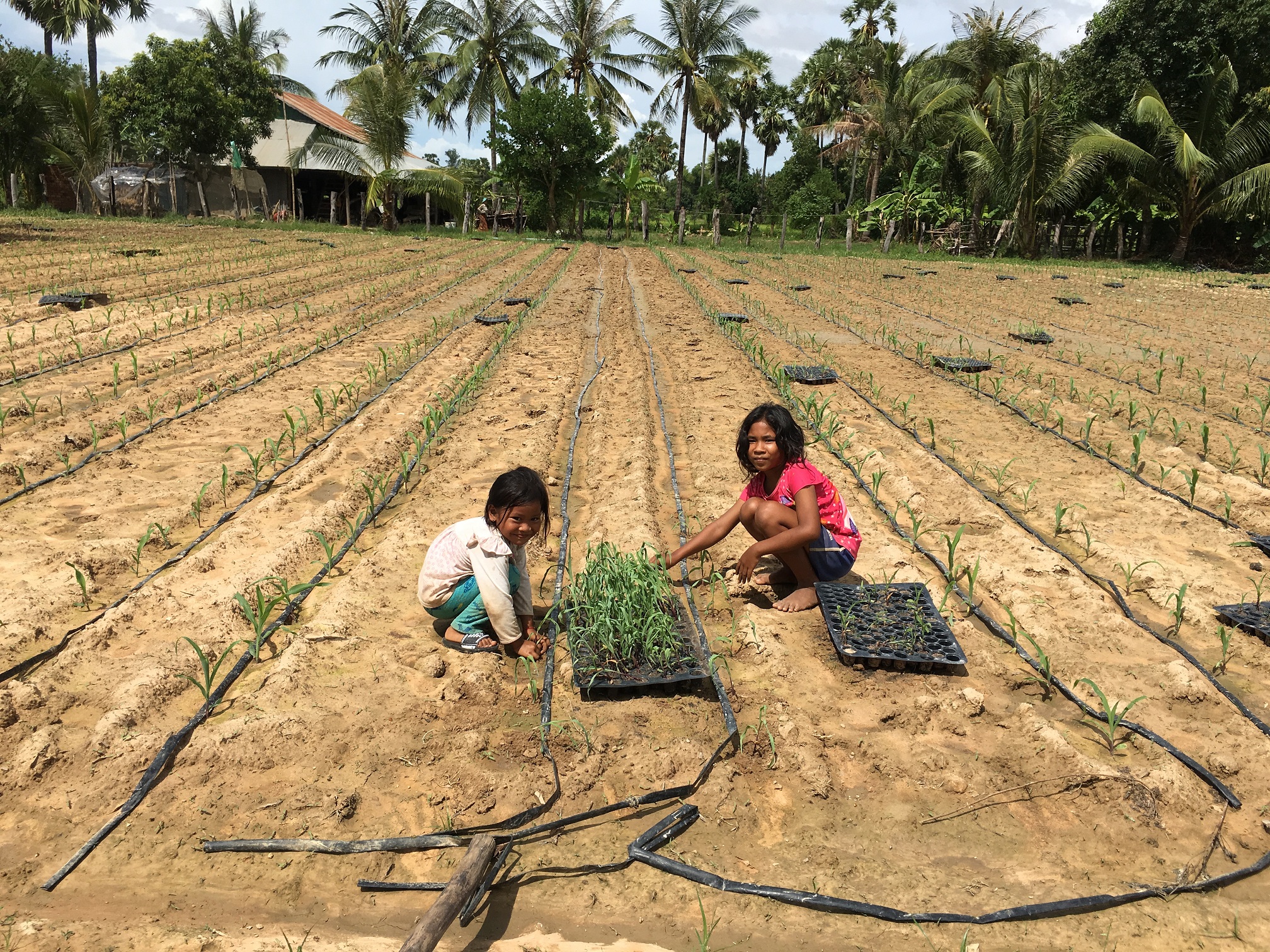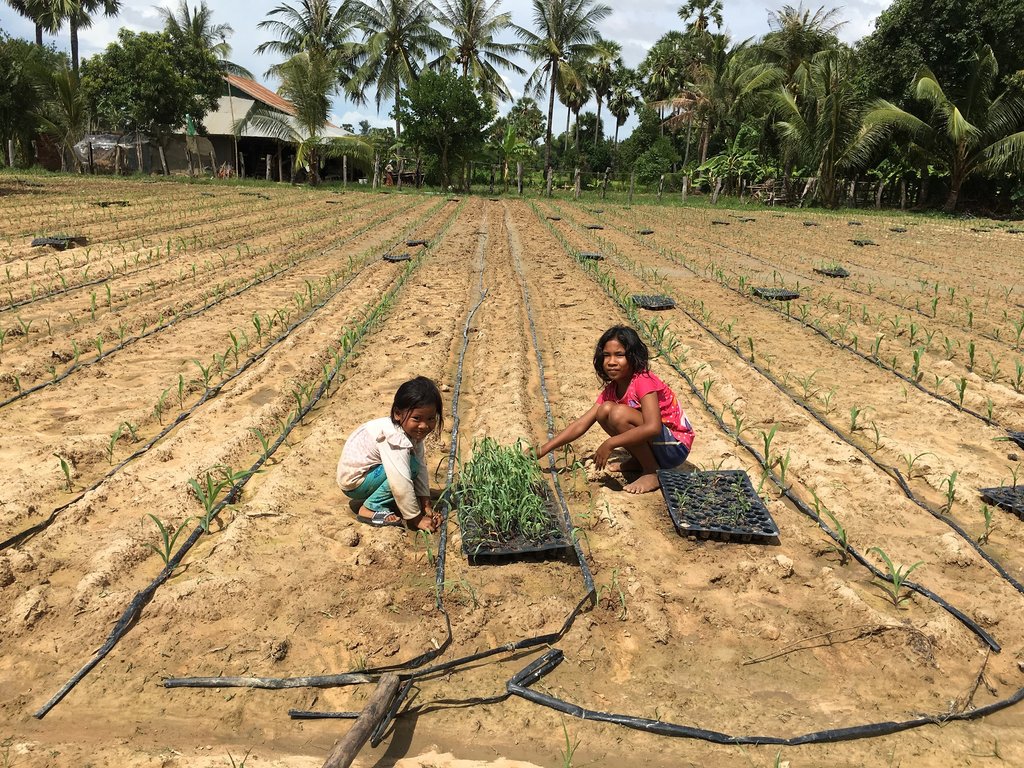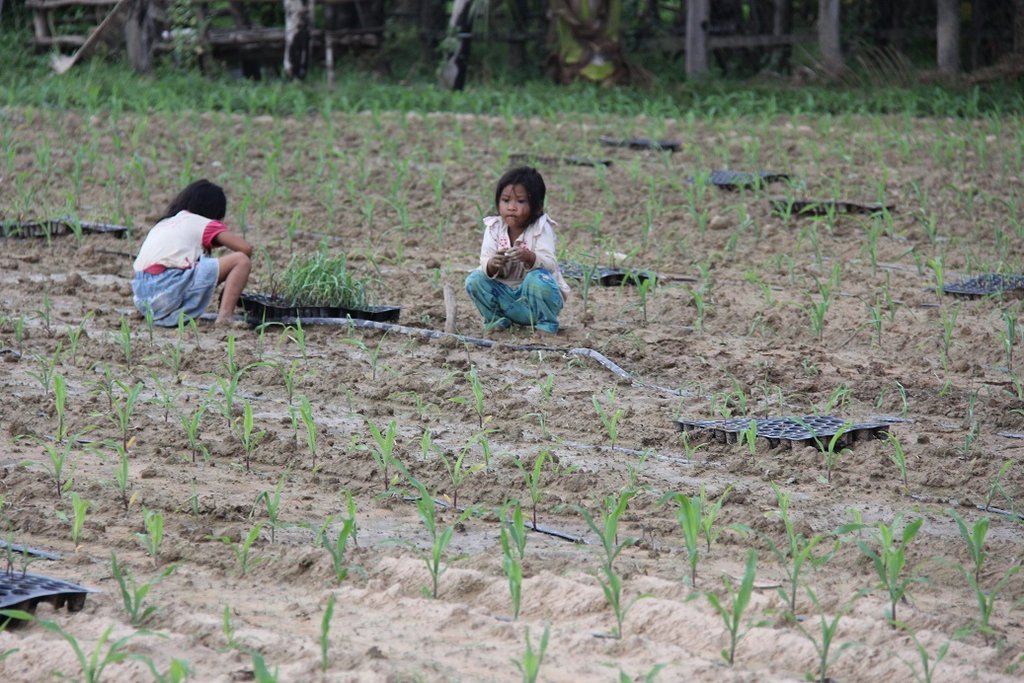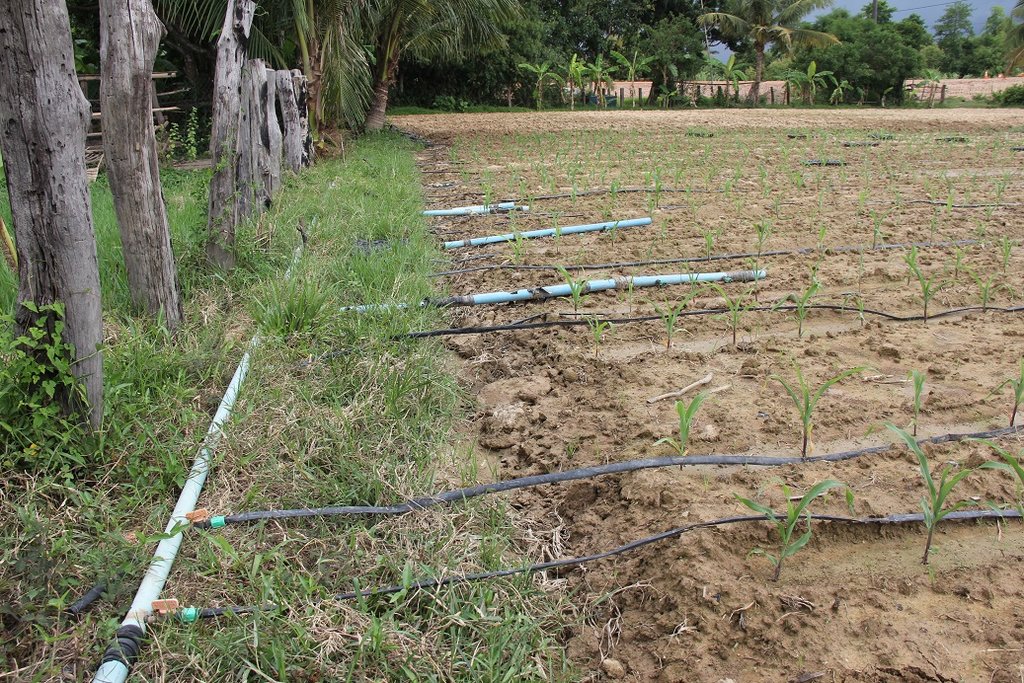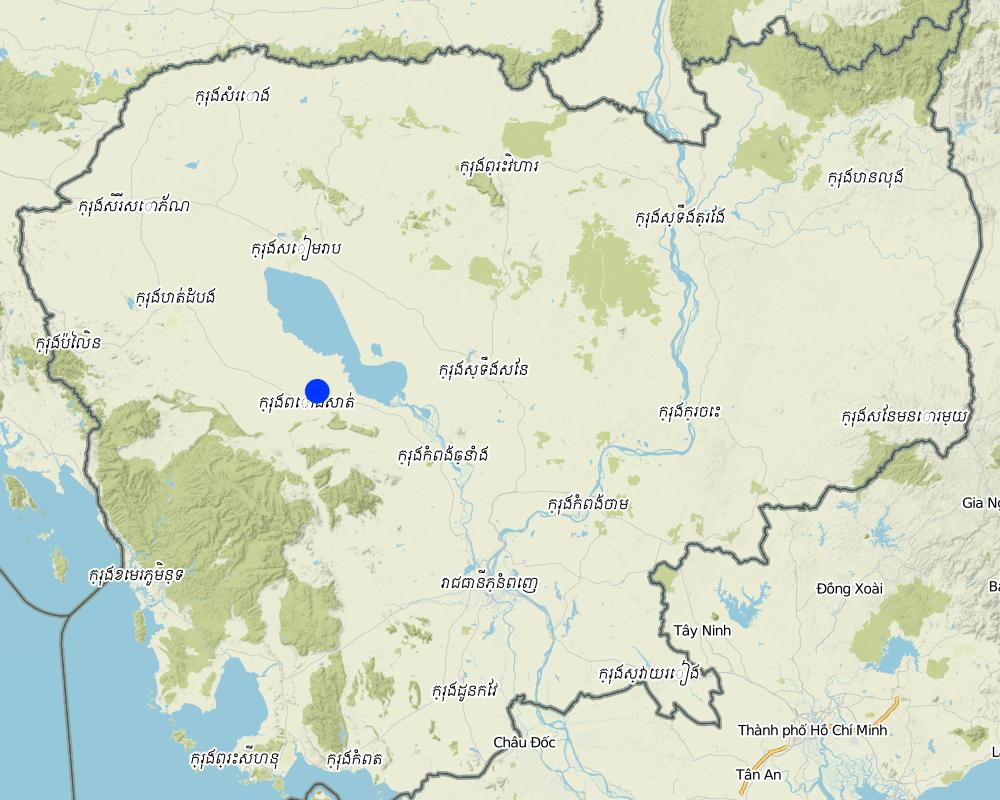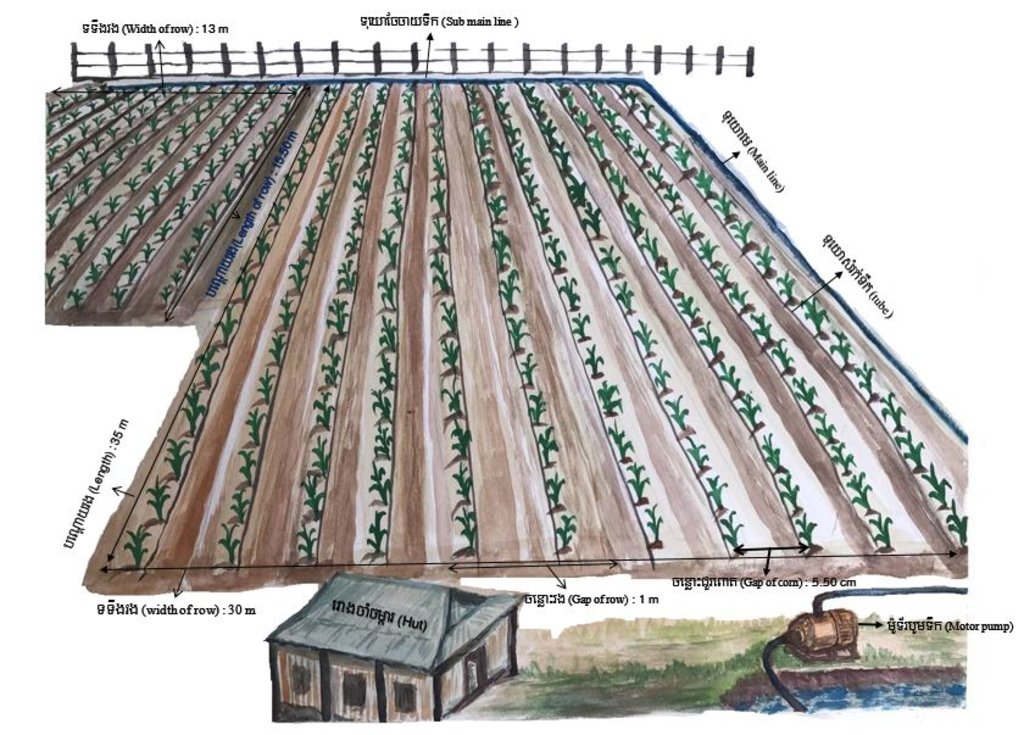Growing corn using drip irrigation system [Cambodia]
- Creation:
- Update:
- Compiler: Nary Lay
- Editors: Navin Chea, Sophea Tim
- Reviewers: SO Than, Alexandra Gavilano, Ursula Gaemperli
Growing corn using drip irrigation
technologies_3144 - Cambodia
View sections
Expand all Collapse all1. General information
1.2 Contact details of resource persons and institutions involved in the assessment and documentation of the Technology
Key resource person(s)
Chief Office of Agricultural Extension at Provincial Department of Agriculture, Forestry and Fisheries, Pursat:
Chief of Agricultural Office of Bakan :
Agronomic Official at Agricultural Office of Kandieng:
Seng Kumpheak
(+855) 96 435 26 65
N/A
Agricultural Office of Kandieng
Kandieng village, Kandiend commune, Kandieng district, Pursat province
Cambodia
Commune Extension Worker at Kandieng Commune:
Chhun Chheng
(+855) 77 93 10 01
N/A
CEW at Kandieng Commune
Sthani village, Kandieng commune, Kandieng district, Pursat province
Cambodia
land user:
Pich Chanthy
(+855) 71 677 221
N/A
Farmer
Kampong Krasang Kraom village, Kandieng communce, Kandieng district, Pursat province
Cambodia
Name of project which facilitated the documentation/ evaluation of the Technology (if relevant)
Scaling-up SLM practices by smallholder farmers (IFAD)Name of the institution(s) which facilitated the documentation/ evaluation of the Technology (if relevant)
Royal University of Agriculture (RUA) - Cambodia1.3 Conditions regarding the use of data documented through WOCAT
When were the data compiled (in the field)?
28/06/2017
The compiler and key resource person(s) accept the conditions regarding the use of data documented through WOCAT:
Yes
1.4 Declaration on sustainability of the described Technology
Is the Technology described here problematic with regard to land degradation, so that it cannot be declared a sustainable land management technology?
No
2. Description of the SLM Technology
2.1 Short description of the Technology
Definition of the Technology:
The cultivation of corn with the use of a drip irrigation system is an efficient technique that saves water and is suitable for irrigation in areas where there is a scarce water supply. Farmers using the drip irrigation system with their corn crops is an adaptation to climate change, in periods such as during the drought period. It’s reduces unnecessary evaporation, saves labor and time, improves crop growth and makes it possible to produce a high yield because of a sufficient water supply.
2.2 Detailed description of the Technology
Description:
The use of a drip irrigation system is an efficient method that saves water by letting it seep through the drainage network directly into the corn clumps at regular intervals (the seepage rate is 6 liters/hour and the pressure of the water flow is between 1.2 to 2 bar). Moreover, the drip system helps to maintain moisture around the roots of a crop and does not distribute water to superfluous areas at a distance from the crop (John, 2018). In doing so it reduces the weed proficiency and also insures that enough water is provided for the crop especially during the flowering phase. This is essential because a lack of water during this phase can have a significant impact on crop yields. At the same time the use of this drip system enables farmers to adapt to climate change through the efficient use of water especially in areas that experience the adverse impacts of climate change like droughts. Furthermore, a liquid fertilizer can also be directly fed into the drip irrigation system.
In order to cultivate corn one should first scatter cow manure on the ground and then plow the soil three times after which it should be left to dry for seven days. After that it should be plowed again and then the soil is prepared for the ridging of the rows. Once the ridges have been created the drip irrigation system should be installed. This technology was applied on a plot of land with an area of 2301.5 square meters.
In order to nurse the seedlings, the farmer should mix the soil from a termite mound (or other fertile soil) with other materials. The ratio should be 1 portion of fertile soil, with 2 portions of rice husk embers and 2 portions of animal manure. Then this mixture is put into trays and then one corn seed is embedded into each cell. After the seedlings are one week old they should be transplanted. The farmer should use a bamboo stick to dig holes to a depth of 3 cm and then firstly apply D A P (18-46-0) fertilizer after which the seedlings are placed in the holes. Nursery seedlings are healthy and well-balanced as they grow, do not die easily, and produce a higher yield than seeds that are directly planted into the ground. These always have to be replanted as some seeds do not grow, and they tend to not germinate as well as the nursery seedlings. Farmers should plant two lines of seedlings in each row with a gap of 55cm between the lines. Along each of the lines there should be a gap of 30cm between one plant and the next. Farmers are able to grow corn twice a year, once from July to September and the other from February to April.
During the rainy season farmers only need to use the irrigation system for about 10 to 15 minutes in the morning or evening once the land is dry, such as when there has been no rainfall for many days or also on occasions of inadequate rainfall. In the dry season farmers water the corn twice a day for about 30 minutes each time, once in the morning and once in the evening. During the dry season 6 to 7 litters of water are used to irrigate the corn, thereby the water flow rate being 6 liters per hour. Depending on the variation in water pressure the flow rate of this drip irrigation system can range between 1 to 4 gallons per hour (1 gallon = 3,785 liters).
The farmers were supported financially by the HARVEST project in 2014 to cover the costs of the drip irrigation system and so their only expenses included the preparation of the seeds, other agricultural inputs and maintenance costs. Regarding the water use for the dry season crop on this area of land, only 600-700 cubic meters of water were consumed, which the farmer sourced from a pond and a small river.
The use of the drip irrigation system helps to reduce the amount of labor necessary for the irrigation of the corn, saves time, is able to maintain unimpaired crop growth when there is not enough water, saves water, and also reduces the growth of weeds between the plants. Therefore, this system facilitates the efficient use of water, helps to adapt to conditions brought on by climate change such as droughts, and is especially beneficial in areas where there is a scarce supply of water.
2.3 Photos of the Technology
2.5 Country/ region/ locations where the Technology has been applied and which are covered by this assessment
Country:
Cambodia
Region/ State/ Province:
Kampong Krasang Kraom village, Kandieng commune, Kandieng district, Pursat province.
Further specification of location:
The farm is near the village.
Map
×2.6 Date of implementation
Indicate year of implementation:
2014
2.7 Introduction of the Technology
Specify how the Technology was introduced:
- through projects/ external interventions
Comments (type of project, etc.):
HARVEST project and the farmer followed the neighborhoods.
3. Classification of the SLM Technology
3.1 Main purpose(s) of the Technology
- improve production
- adapt to climate change/ extremes and its impacts
- create beneficial economic impact
- Reduce water consumption and reduce labor.
3.2 Current land use type(s) where the Technology is applied

Cropland
- Annual cropping
Main crops (cash and food crops):
Corn
If land use has changed due to the implementation of the Technology, indicate land use before implementation of the Technology:
Before it was a rice field and over three years, she changed for other crops.
3.3 Further information about land use
Water supply for the land on which the Technology is applied:
- mixed rainfed-irrigated
Comments:
The water comes from the Steung Pursat river which is nearby .
Number of growing seasons per year:
- 3
Specify:
Growing within one year.
Livestock density (if relevant):
Raise 5 cows
3.4 SLM group to which the Technology belongs
- rotational systems (crop rotation, fallows, shifting cultivation)
- integrated soil fertility management
- irrigation management (incl. water supply, drainage)
3.5 Spread of the Technology
Specify the spread of the Technology:
- applied at specific points/ concentrated on a small area
3.6 SLM measures comprising the Technology

agronomic measures
- A1: Vegetation/ soil cover
- A2: Organic matter/ soil fertility

structural measures
- S7: Water harvesting/ supply/ irrigation equipment
3.7 Main types of land degradation addressed by the Technology

chemical soil deterioration
- Cn: fertility decline and reduced organic matter content (not caused by erosion)

physical soil deterioration
- Pc: compaction
- Pu: loss of bio-productive function due to other activities

biological degradation
- Bc: reduction of vegetation cover

water degradation
- Ha: aridification
3.8 Prevention, reduction, or restoration of land degradation
Specify the goal of the Technology with regard to land degradation:
- prevent land degradation
- reduce land degradation
4. Technical specifications, implementation activities, inputs, and costs
4.1 Technical drawing of the Technology
4.2 Technical specifications/ explanations of technical drawing
The components of the drip irrigation system includes a motor pump, a valve, a filter, a pressure gauge, a main line (with a diameter 60 mm), a sub main line (with a diameter 49 mm), and a tube (diameter 16 mm). The drip irrigation system was applied on a plot of 2301.5 square meters.
Depending on the season there are two ways to prepare the ridges of the rows. Firstly, in the rainy season the farmer should plow the ridges to a height of 50 cm and a width of 1 meter. The gap between each of the rows should be 1 meter and the length of each row is the actual length of the land. In the dry season the ridges of the rows should be plowed to the same length and width but the height should only be 20 cm because in the dry season there is not a lot of rain. Each row gets one drip line.
4.3 General information regarding the calculation of inputs and costs
Specify how costs and inputs were calculated:
- per Technology area
Indicate size and area unit:
2301.5 square meters
other/ national currency (specify):
KHR
Indicate exchange rate from USD to local currency (if relevant): 1 USD =:
4000.0
Indicate average wage cost of hired labour per day:
20000 KHR
4.4 Establishment activities
| Activity | Type of measure | Timing | |
|---|---|---|---|
| 1. | Ploughing the soil | Agronomic | May |
| 2. | Making rows + nursing of corn seedlings+ installing drip irrigation system | Agronomic | May |
| 3. | Making pits + putting fertilizer in pits + planting corn seedling | Agronomic | May |
4.5 Costs and inputs needed for establishment
| Specify input | Unit | Quantity | Costs per Unit | Total costs per input | % of costs borne by land users | |
|---|---|---|---|---|---|---|
| Labour | Plow the soil | Person-day | 4.7 | 20000.0 | 94000.0 | 100.0 |
| Labour | Make row and prepare drip irrigation | Person-day | 2.5 | 20000.0 | 50000.0 | 100.0 |
| Labour | Nursing and planting the corn seedlings | Person-day | 4.0 | 20000.0 | 80000.0 | 100.0 |
| Equipment | Pump motor | Set | 1.0 | 240000.0 | 240000.0 | 100.0 |
| Equipment | Hoe | Piece | 1.0 | 200000.0 | 200000.0 | 30.0 |
| Equipment | Seed tray | Piece | 80.0 | 2500.0 | 200000.0 | 100.0 |
| Plant material | Corn seed | Pack | 3.0 | 28000.0 | 84000.0 | 100.0 |
| Fertilizers and biocides | Fertilizer (D A P, Kaly, Urea) | Kilogram | 7.0 | 2000.0 | 14000.0 | 100.0 |
| Construction material | Pipe | Meter | 100.0 | 1600.0 | 160000.0 | 100.0 |
| Construction material | Tube | Piece | 1.0 | 200000.0 | 200000.0 | 30.0 |
| Total costs for establishment of the Technology | 1322000.0 | |||||
If land user bore less than 100% of costs, indicate who covered the remaining costs:
Harvest project supported the cost of the drip irrigation system.
4.6 Maintenance/ recurrent activities
| Activity | Type of measure | Timing/ frequency | |
|---|---|---|---|
| 1. | Irrigated corn by using drip irrigation system when there is no rain. | Agronomic | drought or dry season |
| 2. | Applying fertilizer 4 times per crop cycle. | Agronomic | during maintenance |
| 3. | Create the ridge of the row after growth of 15 or 18 days | Agronomic | during maintenance |
| 4. | Cutting leaf of corn two times: corn have 20 days and one month | Agronomic | during maintenance |
4.7 Costs and inputs needed for maintenance/ recurrent activities (per year)
| Specify input | Unit | Quantity | Costs per Unit | Total costs per input | % of costs borne by land users | |
|---|---|---|---|---|---|---|
| Labour | Create the ridge of the rows | Person-day | 1.0 | 20000.0 | 20000.0 | 100.0 |
| Labour | Cutting the leafs of the corn | person-day | 1.0 | 20000.0 | 20000.0 | 100.0 |
| Fertilizers and biocides | Fertilizer | Kilogram | 40.0 | 2000.0 | 80000.0 | 100.0 |
| Other | Electricity for water pumping | kilowatt-hour | 267.0 | 790.0 | 210930.0 | 100.0 |
| Total costs for maintenance of the Technology | 330930.0 | |||||
4.8 Most important factors affecting the costs
Describe the most determinate factors affecting the costs:
The seed and the tube are expensive.
5. Natural and human environment
5.1 Climate
Annual rainfall
- < 250 mm
- 251-500 mm
- 501-750 mm
- 751-1,000 mm
- 1,001-1,500 mm
- 1,501-2,000 mm
- 2,001-3,000 mm
- 3,001-4,000 mm
- > 4,000 mm
Specify average annual rainfall (if known), in mm:
1225.70
Specifications/ comments on rainfall:
Annual rainfall in 2015 is 1225.7 mm and in 2014 is 1128.1 mm and in 2013 is 1316 mm.
Indicate the name of the reference meteorological station considered:
Ministry of Water Resources and Meteorology (2015)
Agro-climatic zone
- sub-humid
The weather is warm and humid and there are 2 seasons: dry season and rainy season.
5.2 Topography
Slopes on average:
- flat (0-2%)
- gentle (3-5%)
- moderate (6-10%)
- rolling (11-15%)
- hilly (16-30%)
- steep (31-60%)
- very steep (>60%)
Landforms:
- plateau/plains
- ridges
- mountain slopes
- hill slopes
- footslopes
- valley floors
Altitudinal zone:
- 0-100 m a.s.l.
- 101-500 m a.s.l.
- 501-1,000 m a.s.l.
- 1,001-1,500 m a.s.l.
- 1,501-2,000 m a.s.l.
- 2,001-2,500 m a.s.l.
- 2,501-3,000 m a.s.l.
- 3,001-4,000 m a.s.l.
- > 4,000 m a.s.l.
Indicate if the Technology is specifically applied in:
- not relevant
5.3 Soils
Soil depth on average:
- very shallow (0-20 cm)
- shallow (21-50 cm)
- moderately deep (51-80 cm)
- deep (81-120 cm)
- very deep (> 120 cm)
Soil texture (topsoil):
- medium (loamy, silty)
Soil texture (> 20 cm below surface):
- medium (loamy, silty)
Topsoil organic matter:
- medium (1-3%)
If available, attach full soil description or specify the available information, e.g. soil type, soil PH/ acidity, Cation Exchange Capacity, nitrogen, salinity etc.
pH = 5.5
5.4 Water availability and quality
Ground water table:
5-50 m
Availability of surface water:
good
Water quality (untreated):
good drinking water
Is water salinity a problem?
No
Is flooding of the area occurring?
Yes
Regularity:
episodically
5.5 Biodiversity
Species diversity:
- low
Habitat diversity:
- low
5.6 Characteristics of land users applying the Technology
Sedentary or nomadic:
- Sedentary
Market orientation of production system:
- commercial/ market
Off-farm income:
- 10-50% of all income
Relative level of wealth:
- average
Individuals or groups:
- individual/ household
Level of mechanization:
- manual work
- mechanized/ motorized
Gender:
- women
Age of land users:
- middle-aged
Indicate other relevant characteristics of the land users:
Farmer is 47 years old.
5.7 Average area of land owned or leased by land users applying the Technology
- < 0.5 ha
- 0.5-1 ha
- 1-2 ha
- 2-5 ha
- 5-15 ha
- 15-50 ha
- 50-100 ha
- 100-500 ha
- 500-1,000 ha
- 1,000-10,000 ha
- > 10,000 ha
Is this considered small-, medium- or large-scale (referring to local context)?
- medium-scale
Comments:
For land cultivation: crops 0.5 hectare, rice field 3 hectares but only 1 hectare where she cultivates rice and the other 2 ha she rents to neighbor.
5.8 Land ownership, land use rights, and water use rights
Land ownership:
- individual, titled
Land use rights:
- individual
Water use rights:
- open access (unorganized)
5.9 Access to services and infrastructure
health:
- poor
- moderate
- good
education:
- poor
- moderate
- good
technical assistance:
- poor
- moderate
- good
employment (e.g. off-farm):
- poor
- moderate
- good
markets:
- poor
- moderate
- good
energy:
- poor
- moderate
- good
roads and transport:
- poor
- moderate
- good
drinking water and sanitation:
- poor
- moderate
- good
financial services:
- poor
- moderate
- good
6. Impacts and concluding statements
6.1 On-site impacts the Technology has shown
Socio-economic impacts
Production
crop production
Quantity before SLM:
30%
Quantity after SLM:
80%
Comments/ specify:
By applying drip irrigation system, she can grow crops two or three times per year.
crop quality
Comments/ specify:
Using cow manure and have enough water to use.
risk of production failure
Comments/ specify:
Nursing before planting is making seedling grow well and do not die when planting.
land management
Comments/ specify:
Crop can protect soil erosion and soil have more nutrient than before because using cow manure and soil cover by crop also keep soil moisture well.
Income and costs
expenses on agricultural inputs
Comments/ specify:
Reduce spending on use chemical fertilizer and labor cost.
farm income
Comments/ specify:
Because the growing corn can grow two or three time per year and get high yield.
workload
Comments/ specify:
Do not need much labor for irrigation and maintenance of the corn.
Socio-cultural impacts
food security/ self-sufficiency
Comments/ specify:
Can grow two or three times per year and get high yield.
health situation
Comments/ specify:
Do not effect health because don't use much chemical fertilizer.
SLM/ land degradation knowledge
Comments/ specify:
nursery before planting, using drip irrigation can save water for irrigation crop.
Ecological impacts
Water cycle/ runoff
evaporation
Comments/ specify:
Crop is cover soil reduce evaporation and keep soil moisture as well.
Soil
soil moisture
Comments/ specify:
Crop keep soil moisture well.
soil compaction
Comments/ specify:
The using cow manure make soil not compact and the crop keep moisture because soil can get water daily from drip irrigation system.
soil organic matter/ below ground C
Comments/ specify:
Using cow manure and residue crop help to increase nutrient in soil.
6.2 Off-site impacts the Technology has shown
Comments regarding impact assessment:
មិនមានប៉ះពាល់ទៅដល់បរិវេណខាងក្រៅបច្ចេកទេសទេ
6.3 Exposure and sensitivity of the Technology to gradual climate change and climate-related extremes/ disasters (as perceived by land users)
Gradual climate change
Gradual climate change
| Season | Type of climatic change/ extreme | How does the Technology cope with it? | |
|---|---|---|---|
| annual temperature | increase | very well | |
| annual rainfall | increase | moderately |
Climate-related extremes (disasters)
Climatological disasters
| How does the Technology cope with it? | |
|---|---|
| drought | very well |
6.4 Cost-benefit analysis
How do the benefits compare with the establishment costs (from land users’ perspective)?
Short-term returns:
slightly positive
Long-term returns:
positive
How do the benefits compare with the maintenance/ recurrent costs (from land users' perspective)?
Short-term returns:
positive
Long-term returns:
positive
6.5 Adoption of the Technology
- 1-10%
If available, quantify (no. of households and/ or area covered):
4 households of the village
Of all those who have adopted the Technology, how many have did so spontaneously, i.e. without receiving any material incentives/ payments?
- 0-10%
6.6 Adaptation
Has the Technology been modified recently to adapt to changing conditions?
No
6.7 Strengths/ advantages/ opportunities of the Technology
| Strengths/ advantages/ opportunities in the land user’s view |
|---|
| Reduces the amount of labor necessary for the crop irrigation. |
| Produces a high yield. |
| Strengths/ advantages/ opportunities in the compiler’s or other key resource person’s view |
|---|
| The trays of the seedlings in the corn nursery only require a small amount of soil and the seedlings grow well when they are transferred to the field. |
| Saves time and water for irrigation. |
| There are less weeds and a greater abundance of micro-organisms in the soil, which produces a high yield. |
6.8 Weaknesses/ disadvantages/ risks of the Technology and ways of overcoming them
| Weaknesses/ disadvantages/ risks in the land user’s view | How can they be overcome? |
|---|---|
| The amount of time that is spent collecting the drip line after the crop has been harvested. | Expend effort in collecting the drip line. |
| It is expensive | Farmers need to know how to maintain and connect the drip line by themselves once it breaks, as well as wash it well and handle it properly. |
| The remain drip line cannot be used for anything. | Farmers suggest to burn it or bury it in the soil. |
7. References and links
7.1 Methods/ sources of information
- field visits, field surveys
1 place
- interviews with land users
1 person
- interviews with SLM specialists/ experts
4 people
7.3 Links to relevant information which is available online
Title/ description:
John D. (2018). Corn benefits of Drip Irrigation. John Deere water. Retrieved from
URL:
https://www.deere.com/en_US/docs/agriculture/irrigation_and_water_management/brochure_irrigation_solutions_corn.pdf
Title/ description:
DanChurchAid/Christian Aid. (2015). Farmer book: Kit of best Agriculture Technologies to Adapt with climate change. Ministry of Agriculture, Forestry and Finsheries. In Khmer. Retrieved from
URL:
http://www.maff.gov.kh/agri-tech/78-%E1%9E%80%E1%9E%B6%E1%9E%9A%E1%9E%8A%E1%9E%B6%E1%9F%86%E1%9E%8A%E1%9E%BB%E1%9F%87%E1%9E%8A%E1%9F%86%E1%9E%8E%E1%9E%B6%E1%9F%86/%E1%9E%80%E1%9E%B6%E1%9E%9A%E1%9E%8A%E1%9E%B6%E1%9F%86%E1%9E%8A%E1%9E%BB%E1%9F%87%E1%9E%8A%E1%9F%86%E1%9E%8E%E1%9E%B6%E1%9F%86%E1%9E%95%E1%9F%92%E1%9E%9F%E1%9F%81%E1%9E%84%E1%9F%97%E1%9E%91%E1%9F%80%E1%9E%8F/1586-variety-agriculture.html
Title/ description:
Maff (2014). Technical growing corn. Agricultural magazin. Volum (47). In Khmer. Retrieve from
URL:
www.maff.gov.kh/agri-tech/40.../1161-technical growing corn.html
Title/ description:
Agritoday (2018). Corn planting technique. Ministry of Agriculture, Forestry and Fisheries. In khmer. Retrieved from
URL:
http://agritoday.com/view/1593.html
Title/ description:
Cam Agriculture (2016). The modern irrigation system. CAM AGRICULTURE IMPORT EXPORT LTD. In Khmer. Retrieved from
URL:
http://www.camagriculture.com/drip-irrigation-system/?lang=kh
Links and modules
Expand all Collapse allLinks
No links
Modules
No modules


